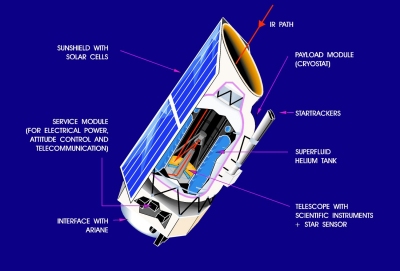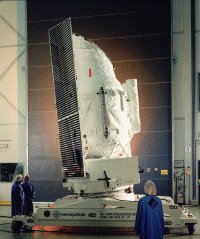Spacecraft
 |
|
Diagram of ISO |
The Satellite Design
The ISO satellite consisted of a payload module and a service module, which provided the basic spacecraft functions. The payload module carried the conical sun shade and the two star trackers. Overall, ISO was 5.3 m high, 2.3 m wide and had a mass of approximately 2500 kg at launch.
The service module included the load path to the launcher, the array of solar cells generating some 600 W mounted on the sun shield, and subsystems for thermal control, data handling, power conditioning, telemetry and telecommand, and attitude and orbit control. The last item provided the three-axis stabilisation to an accuracy of around an arc second, and also the raster pointing facilities needed for the mission. It consisted of sun and earth sensors, star trackers, a quadrant star sensor on the telescope axis, gyros and reaction wheels, and used a hydrazine reaction-control system. The downlink bit rate was 32 kbit/s, of which about 24 kbit/s was dedicated to the scientific instruments.
 |
|
ISO on the ground |
The payload module was essentially a large cryostat. The vacuum vessel enclosed a toroidal tank, which at launch was filled with over 2300 litres of superfluid helium. Some of the infrared detectors were directly coupled to the helium tank and were held at a temperature of around 2K. All other units were cooled by means of the cold boil-off gas from the liquid helium. This was first routed through the optical support structure, where it cooled the telescope and the scientific instruments to temperatures of around 3K. It then passed along the baffles and radiation shields, before being vented to space. Above the main helium tank was a small auxiliary tank (of volume about 60 litres); this contained normal liquid helium and met all of ISO's cooling needs for the period immediately prior to launch. A sunshade was mounted on the outside of the vacuum vessel. This prevented direct sunlight from entering the cryostat.
The telescope was suspended in the middle of the toroidal Liquid Helium tank. It was of Ritchey-Chretien configuration with an effective aperture of 60 cm. The optical quality of its mirrors permitted diffraction-limited performance at a wavelength of 5 microns. Stringent control over straylight, particularly that from bright infrared sources outside the telescope's field of view, was necessary to ensure that the system's sensitivity was not degraded. This was accomplished by means of the sunshade, the Cassegrain and main baffles, and a light-tight shield around the instruments. Additional straylight control was provided by constraining ISO from observing too close to the Sun, Earth and Moon.
Spacecraft vital statistics
| Height | 5.3 m |
| Width | 3.6 m |
| Depth | 2.8 m |
| Launch mass | 2400 kg |
